The ASUS X99 Rampage V Extreme ROG Review
by Ian Cutress on June 22, 2015 8:45 AM EST- Posted in
- Motherboards
- Asus
- ROG
- Haswell-E
- X99
System Performance
Power Consumption
Power consumption was tested on the system while in a single MSI GTX 770 Lightning GPU configuration with a wall meter connected to the OCZ 1250W power supply. This power supply is Gold rated, and as I am in the UK on a 230-240 V supply, leads to ~75% efficiency > 50W, and 90%+ efficiency at 250W, suitable for both idle and multi-GPU loading. This method of power reading allows us to compare the power management of the UEFI and the board to supply components with power under load, and includes typical PSU losses due to efficiency. These are the real world values that consumers may expect from a typical system (minus the monitor) using this motherboard.
While this method for power measurement may not be ideal, and you feel these numbers are not representative due to the high wattage power supply being used (we use the same PSU to remain consistent over a series of reviews, and the fact that some boards on our test bed get tested with three or four high powered GPUs), the important point to take away is the relationship between the numbers. These boards are all under the same conditions, and thus the differences between them should be easy to spot.
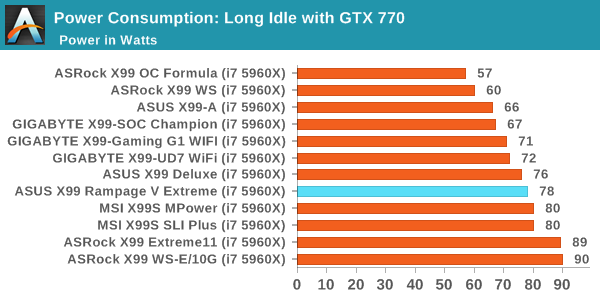

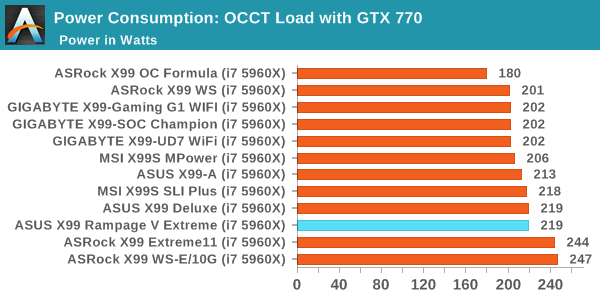
Power Consumption for X99 seems to hover around three points in our test – 200W, 220W and 240W. This puts the Rampage V Extreme in the middle, with similarly placed idle and long idle results.
Windows 7 POST Time
Different motherboards have different POST sequences before an operating system is initialized. A lot of this is dependent on the board itself, and POST boot time is determined by the controllers on board (and the sequence of how those extras are organized). As part of our testing, we look at the POST Boot Time using a stopwatch. This is the time from pressing the ON button on the computer to when Windows 7 starts loading. (We discount Windows loading as it is highly variable given Windows specific features.)
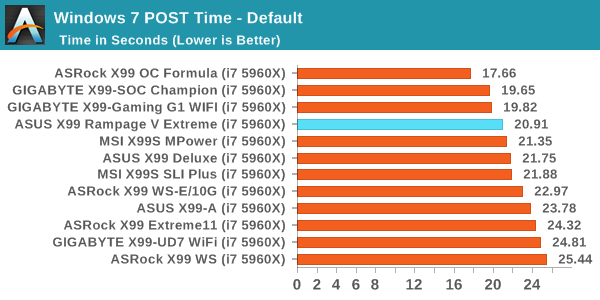
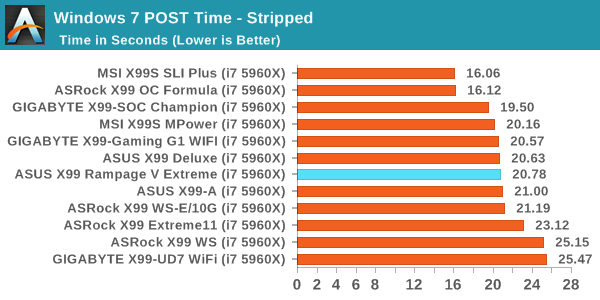
Typically the more hardware features we have, the longer the time to post. In this circumstance the Extreme does well, and the holy grail of 20 seconds for X99 is not too far away. One of the big issues with X99, as we mentioned earlier in the review, is that DRAM training can take up to 50% of this time but is a necessary part in order to ensure stability.
Rightmark Audio Analyzer 6.2.5
Rightmark:AA indicates how well the sound system is built and isolated from electrical interference (either internally or externally). For this test we connect the Line Out to the Line In using a short six inch 3.5mm to 3.5mm high-quality jack, turn the OS speaker volume to 100%, and run the Rightmark default test suite at 192 kHz, 24-bit. The OS is tuned to 192 kHz/24-bit input and output, and the Line-In volume is adjusted until we have the best RMAA value in the mini-pretest. We look specifically at the Dynamic Range of the audio codec used on board, as well as the Total Harmonic Distortion + Noise.
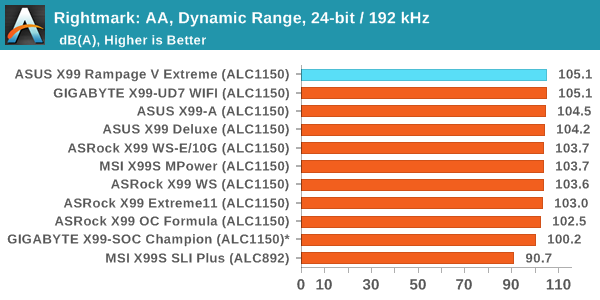
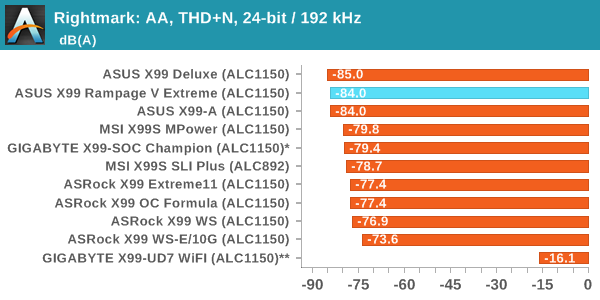
Similar to the X99 Deluxe, the Extreme performs very well here.
USB Backup
For this benchmark, we transfer a set size of files from the SSD to the USB drive using DiskBench, which monitors the time taken to transfer. The files transferred are a 1.52 GB set of 2867 files across 320 folders – 95% of these files are small typical website files, and the rest (90% of the size) are small 30 second HD videos. In an update to pre-Z87 testing, we also run MaxCPU to load up one of the threads during the test which improves general performance up to 15% by causing all the internal pathways to run at full speed.
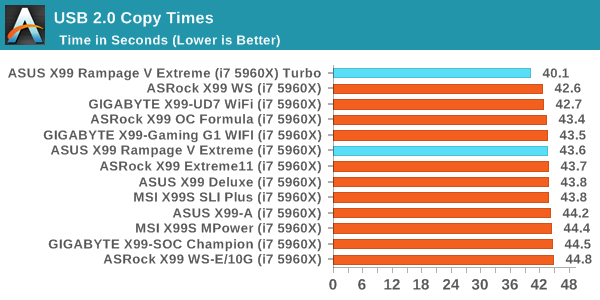
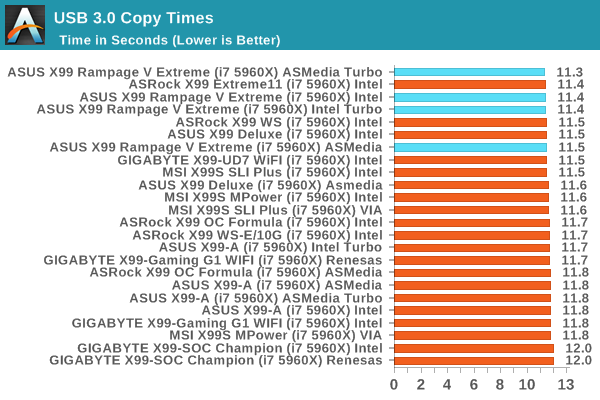
All of our USB 3.0 results have hovered between 11.4 and 12.0 with a couple of outliers, so it is good to see an 11.4 second result.
DPC Latency
Deferred Procedure Call latency is a way in which Windows handles interrupt servicing. In order to wait for a processor to acknowledge the request, the system will queue all interrupt requests by priority. Critical interrupts will be handled as soon as possible, whereas lesser priority requests such as audio will be further down the line. If the audio device requires data, it will have to wait until the request is processed before the buffer is filled.
If the device drivers of higher priority components in a system are poorly implemented, this can cause delays in request scheduling and process time. This can lead to an empty audio buffer and characteristic audible pauses, pops and clicks. The DPC latency checker measures how much time is taken processing DPCs from driver invocation. The lower the value will result in better audio transfer at smaller buffer sizes. Results are measured in microseconds.
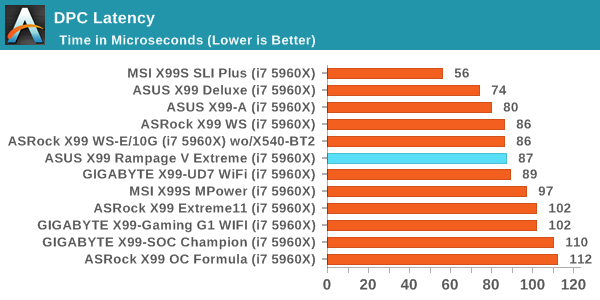
Under 100 microseconds. Tick.










41 Comments
View All Comments
dark4181 - Monday, June 22, 2015 - link
No mention of NVMe support? EATX? Dealbreakers for me. I need ATX formfactor and NVMe support. Looks like I'm getting the X99-Pro/3.1freeskier93 - Monday, June 22, 2015 - link
Asus has already said all Z97 and X99 will have NVMe support, not sure why this would be an exception.SirGCal - Monday, June 22, 2015 - link
Surprised they don't have USB C in there also. Everything else but missing out on the super fast and flexible new USB support. I'll wait some more. And ya, no EATX For me either anymore...BPB - Monday, June 22, 2015 - link
The article states there is a version with USB 3.1DanNeely - Monday, June 22, 2015 - link
It's USB3.1 but still A style connectors, not the new C one. The addin board providing it is PCIe x4; so you're giving up a 4way GPU setup to use it. A minor concern for most people, but it goes toward the existing you can have it all but not all at once problem the board has.BPB - Monday, June 22, 2015 - link
Good points. I don't see a need for the new connector for a while, but I think Asus should have included it.Breit - Tuesday, June 23, 2015 - link
You know this board was released back in august 2014, right?movieman03 - Monday, June 22, 2015 - link
I think they had to go EATX to fit all the PCI-e slots and a full size M.2. There is just a lot going on. I have the Z97 Maximus VII forumula and ASUS gave us a little riser card that limits the physical size of the M.2, so it is nice to see them able to use the full size with this oneDanNeely - Monday, June 22, 2015 - link
"As with any purchase of a high end motherboard for gaming, taking it out of the box is an experience. Only a system builder that has to put together 50 systems a week would get bored of it."Seriously. I think the only time I was even vaguely excited about all the stuff bundled in with a board was 14 years ago when I built my first box. The last time I cared about a major chunk of the bundled stuff was 8 or 9 years ago when I build my first sata box and needed new cables. Now...
Looking at the bundle on Newegg my reactions are: Are those cables with LEDs on the end?!?! Even if I had a case with a Window and wanted to bling my system out in the tackiest gamer style *gag*, those probably wouldn't be the right colors for what I wanted. I've got probably 10 sata cables for every sata drive I own at this point; that's the last thing I need now. Ditto for the collection of SLI bridges. I'll be OCing this box once when I first build it, after that point that OC handset thingy will be totally worthless; and even then sitting on the table is fine I don't need a stand for it. On the plus side, no USB/firewire bracket. On the minus side, it looks like they're missing the one useful bit of the bundle: the little header blocks that let you bundle all the front panel connectors into a single block where you can see what you're doing before plugging them in. (The fact that virtually everyone is using a decade+ old standard for how the headers are laid out; but no case vendor is willing to put them into a unified block continues to enrage me every time I build a new system.)
Schickenipple - Monday, June 22, 2015 - link
I'll second that comment about the switch/LED header blocks. I can't believe it's not a standard by now!